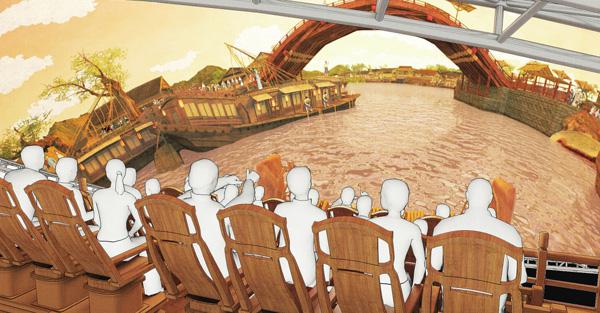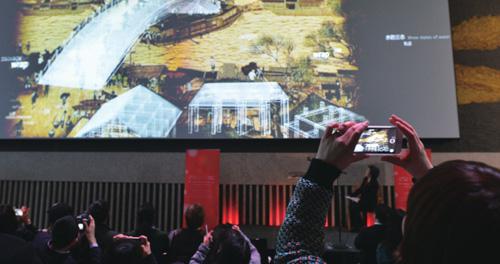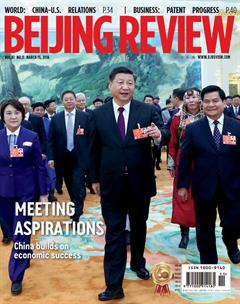Back to the Northern Song
By Li Fangfang
Take a boat into the world of a 1,000 yearold painting and you can not only see how people at the time lived alongside the river upon which you glide, but simultaneously feel the moisture and smell the humidity in the air.
Unfortunately, such an experience is restricted to the virtual reality of the future. Except that it is not. This summer, Beijing residents will get the opportunity to have just such an immersive experience at an exhibition at the Palace Museum, as will overseas audiences in the coming three years.
This is the third part of a highly-interactive exhibition, which seeks to recreate one of Chinas national treasures—the painting Life Along the Bian River at the Pure Brightness Festival (Qingming Shang He Tu). The other three features that complete the installment are an opening show with a contextual introduction to the painting, a multimedia theater space and a creative culture experience area.
With its fine examples of freehand brushwork and elegantly muted pallet of colors, Life Along the Bian River at the Pure Brightness Festival by Zhang Zeduan, an artist who lived toward the end of the Northern Song Dynasty(960-1127), is one of Chinas greatest works of art. It gives a panoramic view of Bianjing—Kaifeng City in Henan Province today—the capital of several ancient dynasties including the Northern Song. This painting is one of the most valuable cultural relics among the 1.8 million artifacts in the Palace Museum collection.
Now, with a boat-shaped 360-degree cinema which offers 24 seats, audiences can start their trip along the river in Zhangs masterpiece.
“The audience can see how people lived along the river as well as experience the gentle movement and spray of the water,” said Zhao Yuyang, project assistant with Phoenix TV Culture Link Development Co. Ltd.
“We usually appreciate an artistic work from outside; however, this project places the audience inside the painting,” said Zhao.
Work on the exhibition began in September 2016, following a strategic partnership between the Palace Museum and Hong Kong-based Phoenix Satellite Television. Over the past year, historians and technicians worked together on the projects research and development, striving to give the audience a realistic experience.
Special challenges
Huang Xiaoyan, CEO of Phoenix Link, described how the painting tells the story of peoples everyday lives, making it relatable to a modern audience.
“If there is a painting that shows the marketplaces and streets of an ancient Chinese city, then it is must be Life Along the Bian River at the Pure Brightness Festival,” Huang told Beijing Review. “It depicts all walks of life in that period, all true to life.”
For Huang and her team, preserving the artistic quality of the piece in the process of digitalization had been a primary concern, but according to Curator of the Palace Museum Shan Jixiang, the exhibition achieves its goal of bringing a national treasure to life. “There are stories to be told about every artifact, especially about a painting with over 800 people and 20 boats in it,” Shan said.
“It is not simply a digital copy of the painting or a game based on it. We hope that the audience can appreciate and experience the exhibition, and still find artistic value in it,” Huang said.
Out of respect for the original painting and the history it tells, the team refrained from taking artistic license to embellish the piece. At one stage an idea was on the table to integrate a love story as part of the exhibition in order to make the show attractive to a wider audience. It made sense since the painting is about social life, but the idea was ultimately abandoned because the creators decided not to add anything disloyal to the original piece.
“We only elaborate on what the painting already has and dont go too far,” Huang added.
Another key focus was the authenticity of the exhibition compared with the painting itself. The team worked thoroughly on every draft.
“For example, as for how many windows in each boat and how many panes in each window, we have made sure that it is true to the original. Even those details that are only visible under a magnifying glass are the same as those in the painting,” Huang told Beijing Review.
Frequent discussions and exchanges with experts at the Palace Museum are a guarantee of the exhibitions academic value. Senior researchers and their doctoral students at the museum have reviewed all accompanying descriptions and information, Huang said.
“The museum only had a few revisions to make in the plan thanks to all the research done ahead of time,” Huang said.
Many people in China today have come to expect a higher quality of life than previous generations. “Our customers and audiences are demanding a better quality of life, and they are eager to learn more about Chinese culture. Our show is the fi rst step toward satisfying this trend, which will be followed by a series of other creative installations for the masterpieces of ancient China.” Huang said.
Future prospects
Visiting exhibitions on the weekend is becoming a feature of urban lifestyle for many of Chinas city residents. The Palace Museum houses more than 1.8 million artifacts, with only a small percentage of them on display.
In order to meet the demand for higher quality cultural services, the Palace Museum has been seeking innovative means of exhibition. This version of Life Along the Bian River at the Pure Brightness Festival has imbued the painting with the values of modernity.
“We have long talked about the integration of history, art and science and technology, and now we have finally achieved it,” Shan said at a news conference in Beijing on February 12.
Liu Changle, Chairman and CEO of Phoenix TV, said that the exhibition blends history, technology and art, presented through 360-degree holographic immersion, stage performance and four dimensional fulldome imaging.
The news of the exhibition announced on February 12 has triggered a wave of discussion on Q&A; website Zhihu.com. Most Internet users have responded positively and expressed their intentions to attend the special exhibition.
“Artifacts could lose their value if they arent modernized alongside society. This exhibition is meaningful to social development,” one user commented on Zhihu.com.
However, for artist Zheng Xueshan, it is not necessary to recreate a work of art. Zheng believes that the painting itself has its own artistic language. “From the perspective of a professional artist, I dont think it respectful to recreate… but this is nonetheless a good try,”Zheng said.
“Life Along the Bian River at the Pure Brightness Festival is well known in China. Now, with advanced technology, we will not only know about but also perceive this painting,”another online commentator said.
Besides offering a more immersive experience for the audience, the exhibition also has a lot to offer other museums.
“For numerous precious collections in museums, new creative elaborations can bring various cultural experiences to visitors and let them have a better understanding of these cultural treasures,” Shan told Beijing Review.
Starting from the Forbidden City, a domestic and international tour is in the pipeline for the next few years. In the past, taking artifacts overseas for exhibition was both risky and costly in terms of transportation and insurance.
“We are still worried at home,” said Shan. “It will be much safer if what we showcase now are devices not relics. Whats more, this exhibition will help to spread more information about our history.”
“This form of multisensory simulation could be attractive to foreign audiences, particularly those who are interested in Chinese culture,”said Huang.

